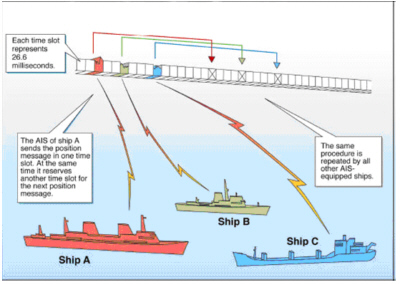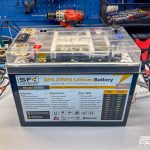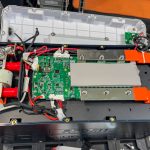AIS Class B, messages & data fields

Geez, this morning I found myself confused about Class B AIS details touched on yesterday, and realized that my sources are somewhat sketchy. The USCG AIS site is pretty informative generally, but its Class B particulars seem suspect, the statement “IEC has begun work on a Class B certification standard, which should be completed by 2003” suggesting that it has not been updated in a long time. I am grateful for the Documentation section of AISParser.com, which is where I found the following message info, much edited and with a few notes added:
Message 18 – Standard Class B CS Position Report: UserID/MMSI, Time, SOG, COG, Longitude, Latitude, True Heading. {CS, or Carrier Sense, integrates “politely” with the Class A protocol known as Self-Organizing Time Division Multiple Access or SOTDMA, illustrated above}.
Message 19 – Extended Class B Equipment Position Report: Same as 18, plus Ship Type and Dimensions {measured bow/stern and port/starboard relative to GPS, which may be why they are often screwed up}.
Message 24 – Class B CS Static Data Report: UserID/MMSI, Boat Name, Ship Type, Call Sign, Dimensions, and Vendor ID {i.e. transponder manufacturer, to help track down problems}.
While I don’t understand the purpose of #19, which seems redundant, I think that the list includes every significant data field that a Class B can transmit. But I could be wrong!













Hmmm … yes it can get confusing…
msg19 is a hang-over from the days when Class B was expected to use the SOTDMA protocol, however it is two slots long, which means that when the CSTDMA protocol was dreamed up, it wouldn’t work (CSTDMA can ONLY be one slot long), so they invented msg24.
However the problem of how to get two slots worth of info into a single CSTDMA slot still remained, so msg24 was split into two, 24a and 24b. The 24b is sent within a minute of the 24a so when both have been received, all the data is then available.
…oh and I believe that there is a Class B SOTDMA standard somewhere, so msg19 may come back at sometime in the future…..
All message fields included, and indeed msg 19 is a left-over from the time when a Class B SOTDMA was envisaged. This Class B SOTDMA is not yet fully defined, but it is still possible that it could be defined for some purposes. However msg 19 can still be polled from a Class B CSTDMA Transponder by a coastal basestation (which also reserves the slots).
Ya know, i’m highly inclined to just write-off AIS Class B as “write when you get work” vaporware and go with a full Class A transponder. what would be very interesting would be a Class-A transponder minus the SOLAS certification crapola that insists on the nearly-useless “minimum display unit” thing. just a “black-box” Class A unit that doesn’t care about SOLAS. that I’d buy in a heartbeat. sigh.
Mike:
Not entirely sure I understand the thrust of your comment, however Class B is most definitely NOT vapourware – there is kit out there ready to be sold as soon as the FCC gets itself sorted out (I passed the factory where one is being made only yesterday).
The Class B SOTDMA would effectively been your Class A without the SOLAS stuff, but I don’t know what’s happened to it recently – if you really want one, best lobby your national IEC / IMO / ITU / IALA representative to get it moving again.
And yes, I agree that the Minimum display (MKD) thing IS a waste of time….
On the other hand, it is perfectly legal for a yacht to install a Class A transponder, they transmit more data at a higher rate and power, and I do believe there are manufacturers working on non-Solas, less pricey models.
Hi all,
Thx for clearing out a little bit of the messy info I read about AIS. I live in Spain, where more and more people carry receivers, but hardly anyone a transponder.
If I may contribute from my experience Mike, I recently bought one in http://www.aisred.com/shop, where they sell True Heading’s for as little as 720+VAT (I think VAT does not apply to exports outside the EU) and I must say that knowing all those huge ships could see me, definitely made my trip a lot easier!!
“I recently bought one in http://www.aisred.com/shop, where they sell True Heading’s for as little as 720+VAT”
….and if you scroll down to the next item in their shop, which is the True Heading Class B with GPS and VHF antennas, it came up as 0.00 euros!!!! Sounds like the bargain of the century to me! I don’t suppose by any chance that they will honour the price though…..
Hi,
I forgot to mention that the trip was around Spain, through Gibraltar’s strait, very busy always, and proved very useful particularly there.
Seems like they’ve added a price: 835.20. If full Class-B AIS is really “just around the corner”, at $1000 or so, I may wait.
Tim:
Class B WILL get cheaper, just wait for the competition to hot up a bit. At the moment it looks like the SRT-based design has the lions share of the design-ins, but I KNOW it can be done for less dollars AND fewer milli-amps.
I would like to add one more Class B message: message 14 (even if it is optional one).
Class B messages
Class B transmits the following messages:
message 18, Standard Class B Equipment Position Report
message 24, Class B CS Static data (Part A and Part B)
message 19 Extended Class B Equipment Position Report (transmit ONLY as response on Base Station interrogation)
message 14, Safety Related Broadcast Message (optional, transmit with predefined text only)
About message 19:
Message 19 is specific to class B AIS and contains ship static and dynamic data and is a 2 slot message. This message is defined in ITU1371-1 and all class A transponders in the field should be aware of it
Message 24 is specific to class B AIS and contains ship static data and consists of 2, single slot messages, message 24A and message 24B. It is a new message, not defined in ITU1371-1 and hence class As in the field are not aware of it and hence its contents will not be displayed on the MKD (without a software upgrade to the MKD).
A class B can be polled for message 18, 19 and 24 via a personally addressed message 15. But only Base Station is able to guarantee that future slots are empty, via the FATDMA mechanism (message 20). So only a Base Station can interrogate a CS B for message 19. Therefore, if a BS interrogates a class B for message 19, the class B will transmit in the 2 slots specified in the message 15 offset and all class As in range will therefore hear the resultant message 19, present it on the PI output (in a !VDM) and hence available for display.
how can i simulate the message tupe 18 and 19 in C++?
any one send me a C++ code please
thanks
I’m not a coder, but maybe these sites will help?
https://github.com/schwehr/libais
https://arundaleais.github.io/docs/ais/ais_decoder.html